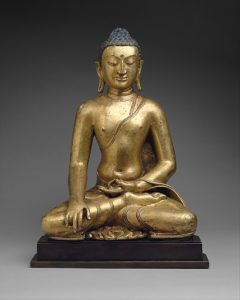 Yoga Sutras, it is written:
Yoga Sutras, it is written:
Yoga is the control of thought waves in the mind (Sutra 2.)
In Ashtanga yoga, the last four limbs of the practice are pranayama, dharana, dhyana, and samadhi. In yoga there are many ways to meditate; what works for one person will not work as well for another. We all have different constitutions and temperaments. Yoga has evolved over the centuries to meet these needs.
When the Breath Becomes Calm
The Mind Becomes Calm
Pranayama translates most simply as “breath control,” or the careful regulation of breath during meditation; it is central to all yogic meditation practice. The poses in hatha yoga all work to open up the body so that life energy can flow without restriction, because breath, posture, and life force are connected. This can be seen, for example, in the way that anxious or depressed people hold their bodies. With depression, people often slump their shoulders in resignation. This causes the back to curve and the chest to collapse, compressing the lower spine, which in turn makes breathing shallow and constricts the flow of prana. Anxious people also breathe shallowly, from the chest area, which prevents breath from flowing into the belly. In contrast, a healthy person’s breath flows naturally from the nostrils to the belly; both inhalation and exhalation are free from restriction.
Using the breath to calm the mind’s thought waves (vrittis) will bring about more peaceful states of mind. When someone is anxious or agitated, their breathing becomes rapid and shallow, which is associated with increased thinking. It can take the form of worry, rumination, fretting, or fear. The thoughts and the breath are intimately connected. In western medicine, anxiety has historically been treated with medications. But by practicing mindful breathing and meditation, anxiety can be controlled.
When the breath is arrhythmic the mind wanders, but when it is smooth the mind becomes still, and the aspirant attains the power of stillness. Therefore the breath should be restrained.
Aphorism 2.2 from Hathayoga Pradipika
In yoga sutra 2:52 Pantanjali describes the effect of practicing pranayama:
From that the covering of the light dissolves.
Pranayama removes the coverings, the excesses of rajas and tamas gunas in the mind that prevent the light of knowledge from shining. The impurities are gradually reduced, and sattva dominates. The mind becomes ready for concentration.
Pratyahara is the process of withdrawing the mind from the senses. It is the fifth limb of Patanjali’s eightfold yoga. Dharana is the effort to retain only one object of concentration in the mind—in other words, concentration, or one-pointedness. When we are focused on an activity in full absorption, we are free from tension. This has been expressed as being in the moment, or in the flow.
Dhyana is true meditation. It is the continuous, uninterrupted flow of identical thought waves in the mind. Through dharana, the meditator deepens concentration on a chosen object until concentration flows without interruption.
People often give up meditation because it is too long or too boring. Practicing in short bursts, as in the mindfulness meditation described below, can be incorporated throughout the day and help build up to longer periods of sitting meditation.
- Psychotherapy in the Virtual Space: How teletherapy has changed the way we give and get care - April 26, 2021
- (home video area – couples counseling) - November 23, 2011
- (home video area – mindfulness) - November 23, 2011


Leave a Reply